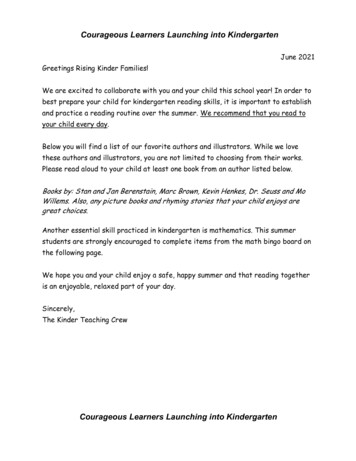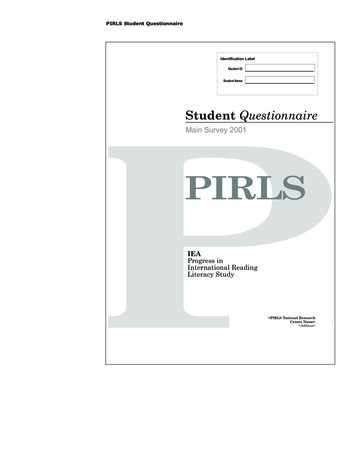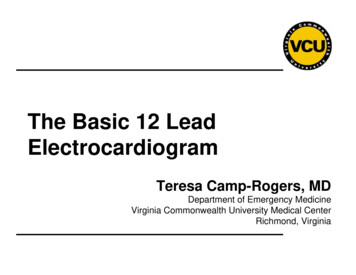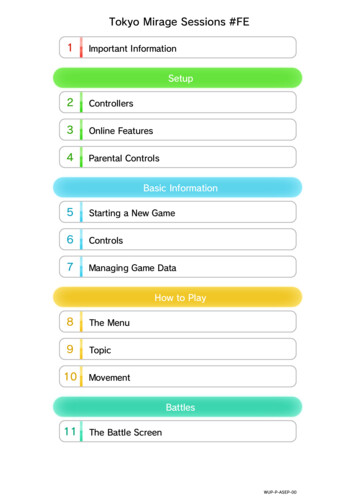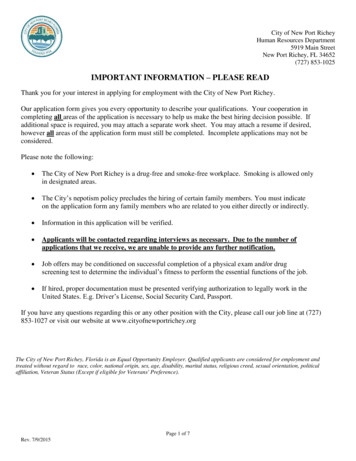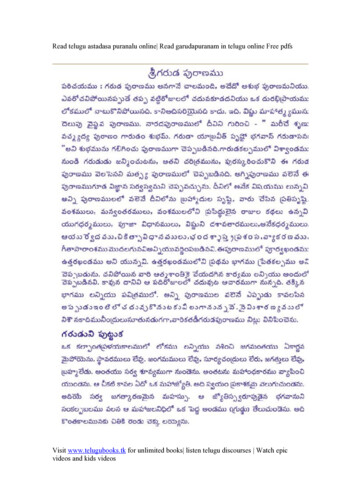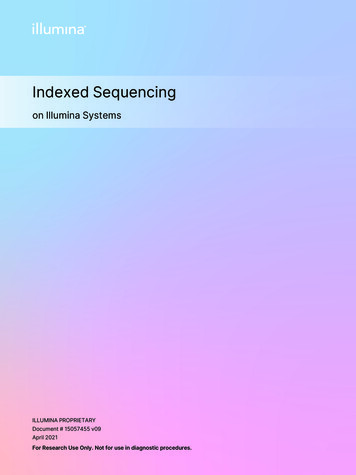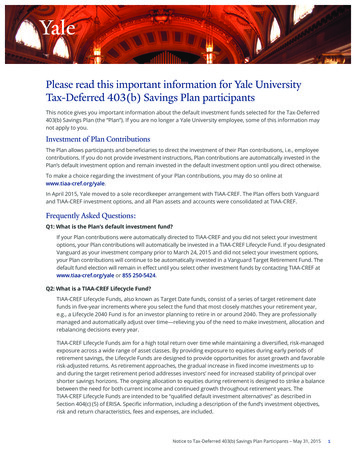
Transcription
Please read this important information for Yale UniversityTax-Deferred 403(b) Savings Plan participantsThis notice gives you important information about the default investment funds selected for the Tax-Deferred403(b) Savings Plan (the “Plan”). If you are no longer a Yale University employee, some of this information maynot apply to you.Investment of Plan ContributionsThe Plan allows participants and beneficiaries to direct the investment of their Plan contributions, i.e., employeecontributions. If you do not provide investment instructions, Plan contributions are automatically invested in thePlan’s default investment option and remain invested in the default investment option until you direct otherwise.To make a choice regarding the investment of your Plan contributions, you may do so online atwww.tiaa-cref.org/yale.In April 2015, Yale moved to a sole recordkeeper arrangement with TIAA-CREF. The Plan offers both Vanguardand TIAA-CREF investment options, and all Plan assets and accounts were consolidated at TIAA-CREF.Frequently Asked Questions:Q1: What is the Plan’s default investment fund?If your Plan contributions were automatically directed to TIAA-CREF and you did not select your investmentoptions, your Plan contributions will automatically be invested in a TIAA-CREF Lifecycle Fund. If you designatedVanguard as your investment company prior to March 24, 2015 and did not select your investment options,your Plan contributions will continue to be automatically invested in a Vanguard Target Retirement Fund. Thedefault fund election will remain in effect until you select other investment funds by contacting TIAA-CREF atwww.tiaa-cref.org/yale or 855 250-5424.Q2: What is a TIAA-CREF Lifecycle Fund?TIAA-CREF Lifecycle Funds, also known as Target Date funds, consist of a series of target retirement datefunds in five-year increments where you select the fund that most closely matches your retirement year,e.g., a Lifecycle 2040 Fund is for an investor planning to retire in or around 2040. They are professionallymanaged and automatically adjust over time—relieving you of the need to make investment, allocation andrebalancing decisions every year.TIAA-CREF Lifecycle Funds aim for a high total return over time while maintaining a diversified, risk-managedexposure across a wide range of asset classes. By providing exposure to equities during early periods ofretirement savings, the Lifecycle Funds are designed to provide opportunities for asset growth and favorablerisk-adjusted returns. As retirement approaches, the gradual increase in fixed income investments up toand during the target retirement period addresses investors’ need for increased stability of principal overshorter savings horizons. The ongoing allocation to equities during retirement is designed to strike a balancebetween the need for both current income and continued growth throughout retirement years. TheTIAA-CREF Lifecycle Funds are intended to be “qualified default investment alternatives” as described inSection 404(c) (5) of ERISA. Specific information, including a description of the fund’s investment objectives,risk and return characteristics, fees and expenses, are included.Notice to Tax-Deferred 403(b) Savings Plan Participants – May 31, 20151
Q3: What is a Vanguard Target Retirement Fund?Vanguard’s Target Retirement Funds consist of twelve separate lifecycle funds that offer a simple way foryou to invest for retirement. Each fund is a multifund portfolio designed for a specific retirement timeframe. Plan contributions that are defaulted to a Vanguard Target Retirement Fund are invested in thefund that is closest to the year in which you will attain age 65.The fund’s asset allocation will automatically adjust, both now and in the future, relying on Vanguard’sinvestment strategies and extensive research. Each fund invests in a diversified combination of underlyingVanguard funds, primarily index funds, chosen from among five options. Through the underlying funds,you have a well-diversified portfolio that potentially offers exposure to small-, mid- and large-cap domesticand international stocks as well as bonds and money market instruments. The asset mix gradually andautomatically becomes more conservative, reducing the proportion invested in stocks, as you approachand enter retirement. These funds seek to provide capital appreciation and current income consistent withtheir current asset allocations. The Vanguard Target Retirement Funds are intended to be “qualified defaultinvestment alternatives” as described in Section 404(c)(5) of ERISA. Specific information, includinga description of the fund’s investment objectives, risk and return characteristics and fees and expensesare attached.Q4: May I change the automatic investment of my Plan contributions?If your Plan contributions are automatically invested in a TIAA-CREF Lifecycle or Vanguard TargetRetirement Fund, you have the right at any time to change the investment of your future and pastPlan contributions among the available investment options in the Plan. If you do nothing, your Plancontributions will continue to be invested in a TIAA-CREF Lifecycle or Vanguard Target Retirement Fund.Q5: How do I change the investment of my Plan contributions?Investment changes for future Plan contributions can be made online at www.tiaa-cref.org/yale or bycalling TIAA-CREF at 855 250-5424. To learn more about the Plan’s investment options and procedures forchanging how your Plan account is invested, log on to your account at www.tiaa-cref.org/yale or callTIAA-CREF at 855 250-5424.Q6: What else do I need to think about?In addition to reviewing how your contributions are invested, you should also review and update yourbeneficiary designation(s) if it does not reflect how you would want your assets distributed upon your death.To view or change your beneficiary designation, visit www.tiaa-cref.org/yale and log in to your secureaccount or register for online access. Click on the Manage My Portfolio tab, and choose Beneficiaries underthe Quick Links heading. To register for secure online access visit www.tiaa-cref.org/yale. Click on Register,then select Register for Online Access to establish your user ID and password. For assistance with setting upa user ID and password call TI AA-CREF at 855 250-5424, Monday to Friday, 8 a.m. to 10 p.m. or Saturday,9 a.m. to 6 p.m. (ET).Keep in mind that if prior to April 24th you had a TIAA-CREF and a Vanguard account, the beneficiarydesignation on your existing TIAA-CREF account will apply to the Vanguard assets that were transferredto TIAA-CREF. If you had only a Vanguard account, your prior beneficiary designation on your Vanguardaccount was not transferred to TIAA-CREF. Your beneficiary designation will be defaulted to your estateuntil you make a new beneficiary designation.141008956424721 533903 TD
VanguardVanguard Target Retirement Funds - Investor Share ClassTarget DateGlidepath StrategyAS OF 03/31/2015Investment Glidepath 1Target-date funds employ glidepaths,which are the planned progression ofasset allocation changes (e.g., mix ofequity and fixed-income investments)along specific points in time. Afund’s glidepath generally shows howits asset allocation shifts from amore aggressive to a moreconservative investment approach asthe fund moves toward and beyondits target date.100%90%Target %80%70%60%50%Fixed Income40%Equities30%20%For more informationplease contact:10%0%800 842-2252 Weekdays 8 a.m. to10 p.m. ET, Saturdays 9 a.m. to6 p.m. ET, or visit rs to Years PastTarget DateTarget Date1Glidepath data is presented based on the most current prospectus.What are Target-Date Funds?Target-date funds (also commonly referred to as "lifecycle funds," "retirement funds" and "age-based funds") are managed based on the specific retirement year(target date) included in its name and assumes an estimated retirement age of approximately 65. In addition to age or retirement date, investors should considerfactors such as their risk tolerance, personal circumstance and complete financial situation before choosing to invest in a target-date fund. These funds aregenerally designed for investors who expect to invest in a fund until they retire (the target date), and then begin making gradual systematic withdrawals afterward.There is no guarantee that an investment in a target-date fund will provide adequate retirement income, and investors can lose money at any stage of investment,even near or after the target date.Years toTarget DateBirth YearTarget FundTicker501993 PresentTargetRetirement2060 FundVTTSX454035302520151050Retired1988 - 1992 1983 - 1987 1978 - 1982 1973 - 1977 1968 - 1972 1963 - 1967 1958 - 1962 1953 - 1957 1948 - 1952 1943 - 1947 1900 - 1942TargetRetirement2055 FundTargetRetirement2050 FundTargetRetirement2045 FundTargetRetirement2040 FundTargetRetirement2035 FundTargetRetirement2030 FundTargetRetirement2025 FundTargetRetirement2020 FundTargetRetirement2015 FundTargetRetirement2010 FundRetirementIncome TENXVTINX
VanguardVanguard Target Retirement Funds - Investor Share ClassTarget DateAS OF 03/31/2015Investment Objective and StrategyThe investments seek to provide capital appreciation and current income consistent with their current asset allocation. The funds invest in other Vanguard mutual funds according to an asset allocation strategydesigned for investors planning to retire and leave the workforce in or within a few years of the target year. At any given time, their asset allocation may be affected by a variety of factors, such as whether theunderlying funds are accepting additional investments. The funds' indirect stock holdings are a diversified mix of U.S. and foreign large-, mid- and small-capitalization stocks.Morningstar RatingThe Overall Morningstar Rating is based on risk-adjusted return, and is a weighted average of the applicable 3-, 5- and 10-year ratings.PerformanceThe returns quoted represent past performance, which is no guarantee of future results. Returns and the principal value of your investment will fluctuate. Current performance may be higher or lower than thatshown, and you may have a gain or a loss when you redeem your mutual fund shares. For current performance information, including performance to the most recent month-end, please visit tiaa-cref.org, or call800 842-2252. Performance may reflect waivers or reimbursements of certain expenses. Absent these waivers or reimbursement arrangements, performance may be lower.Birth YearYears to RetirementTickerTarget Retirement 2060Fund 2Target Retirement 2055Fund 2Target Retirement 2050Fund 2Target Retirement 2045Fund 2Target Retirement 2040Fund 2Target Retirement 2035Fund 21993 - Present1988 - 19921983 - 19871978 - 19821973 - 19771968 - %2.38%2.36%2.41%2.39%2.35%Inception DateTotal ReturnsAverage Annual Total Returns1 .18%0.18%0.18%0.18%0.18%0.18%------Overall /108 /108 /173/143 /193 /1443 Years /108 /108 /173 /143 /193 /1445 Years-- /127 /111 /164 /11210 Years----- /23Target Date 2051 Target Date 2051 Target Date 2046-2050Target Date 2041-2045Target Date 2036-2040Target Date 2031-2035Since InceptionExpensesWaiver/Cap ExpiresMorningstar RatingMorningstar Category
VanguardVanguard Target Retirement Funds - Investor Share ClassTarget Date2AS OF 03/31/2015Target Retirement 2030Fund 2Target Retirement 2025Fund 2Target Retirement 2020Fund 2Target Retirement 2015Fund 2Target Retirement 2010Fund 2Retirement Income Fund 21963 - 19671958 - 19621953 - 19571948 - 19521943 - 19471900 - 0.16%0.16%0.16%0.16%------ /194 /144 /194 /125 /116 /150 /194 /144 /194 /125 /116 /150 /165 /112 /165 /116 /109 /136- /23- /23- /55Target Date 2026-2030Target Date 2021-2025Target Date 2016-2020Target Date 2011-2015Target Date 2000-2010Retirement IncomeAccumulations in mutual funds not managed by TIAA-CREF may be subject to administrative charges. These charges are subject to change. Please review current documents related to your plan.The annual expense charge may include fees for the target-date fund and fees for the underlying funds; in general, target-date funds indirectly bear their pro rata share of the fees and expenses incurred by theunderlying funds.
VanguardVanguard Target Retirement Funds - Investor Share ClassTarget DateAS OF 03/31/2015Important InformationMutual funds are offered through your plan sponsor's retirement plan, which is administered by TIAA-CREF. Funds are offered at that day's net asset value (NAV), and the performance is displayed accordingly.Performance at NAV does not reflect sales charges, which are waived through your pension plan. If included, the sales charges would have reduced the performance quoted.Investment, insurance and annuity products: are not FDIC insured, are not bank guaranteed, are not deposits, are not insured by any federal government agency, are not a condition to any bankingservice or activity, and may lose value.TIAA-CREF Individual & Institutional Services, LLC, Teachers Personal Investors Services, Inc., and Nuveen Securities, LLC, Members FINRA and SIPC, distribute securities products. You should considerthe investment objectives, risks, charges and expenses carefully before investing. Please call 877 518-9161 for a prospectus that contains this and other information. Please read the prospectuscarefully before investing.Morningstar DisclosureData Provided by Morningstar, Inc. 2015 Morningstar, Inc. All Rights Reserved. The information contained herein: (1) is proprietary to Morningstar and/or its content providers; (2) may not be copied ordistributed; and (3) is not warranted to be accurate, complete or timely. Neither Morningstar nor its content providers are responsible for any damages or losses arising from any use of this information.Neither TIAA nor its affiliates has independently verified the accuracy or completeness of this information.The Morningstar Category classifies a fund based on its investment style as measured by underlying portfolio holdings (portfolio statistics and compositions over the past three years). If the fund is new andhas no portfolio, Morningstar estimates where it will fall before assigning a more permanent category. When necessary, Morningstar may change a category assignment based on current information.To determine a fund's star rating for a given time period (three, five, or 10 years), the fund's risk-adjusted return (including the effects of sales charges, loads and redemption fees) is plotted on a bell curve.The top 10% of funds in each category receive 5 stars, the next 22.5% receive 4 stars, the next 35% earn 3 stars, the next 22.5% receive 2 stars, and the bottom 10% receive 1 star. Morningstar RatingTM isfor individual share classes only. Other classes may have different performance characteristics.A Note About RisksTarget-date mutual funds share the risks associated with the types of securities held by each of the underlying funds in which they invest. As with all mutual funds, the principal value isn't guaranteed. Also,please note that the target date is an approximate date when investors may begin withdrawing from the fund. Target-date mutual funds are actively managed, so their asset allocations are subject tochange and may vary from those shown. After the target date has been reached, some of these funds may be merged into a fund with a more stable asset allocation. An investment in a target-date mutualfund is subject to various types of investment risk, which may include but is not limited to:Active Management Risk, the risk that a fund may underperform because of the allocation decisions or individual security selections of its portfolio manager; Asset Allocation Risk, the risk that the selectionof investments and the allocation among them will result in the fund's underperformance versus similar funds or will cause an investor to lose money; Call Risk, the risk that, during periods of declininginterest rates, an issuer of a bond may “call” (i.e., redeem) a bond prior to maturity, and the associated risk that bondholders will be reinvesting the proceeds at a lower interest rate; Company Risk, the riskthat the financial condition of a company may deteriorate, causing a decline in the value of the securities it issues; Credit Risk, the risk that an issuer of bonds may default; Current Income Risk, the risk thatthe income a fund receives may unexpectedly fall as a result of a decline in interest rates; Emerging Markets Risk, the risk that securities issued in developing markets, where there is greater potential forpolitical, currency and economic volatility, may be less liquid than those issued in more developed countries and foreign investors in these markets may be subject to special restrictions which could have anadverse impact on performance; Extension Risk, the risk that a security’s duration will lengthen, due to a decrease in prepayments caused by rising interest rates; Foreign Investment Risk, the risk thatsecurities of foreign issuers may lose value because of erratic market conditions, economic and political instability or fluctuations in currency exchange rates, which may be magnified in emerging markets;Growth Investing Risk, the risk that, due to their relatively high valuations which are generally a function of expected earnings growth, growth stocks will be more volatile than value stocks and such earningsgrowth may not occur or be sustained; Income Volatility Risk, the risk that the income from a portfolio of securities may decline in certain interest rate environments; Index Risk, the risk that a fund'sperformance may not match that of its benchmark index; Interest Rate Risk, the risk that interest payments of debt securities may become less competitive during periods of rising interest rates anddeclining bond prices; Large-Cap Risk, the risk that large companies may grow more slowly than the overall market; Liquidity Risk, the risk that illiquid securities may be difficult to sell at their fair marketvalue; Market Risk, the risk that the price of securities may fall in response to economic conditions; Mid-Cap Risk, the risk that stocks of mid-capitalization companies may have greater price volatility, lowertrading volume and less liquidity than the stocks of larger, more established companies; Prepayment Risk, the risk associated with the early unscheduled return of principal on fixed-income investments, suchas mortgage-backed securities; Risks of inflation-indexed bonds, the risks that interest payments on inflation-indexed bonds may decline because of a change in inflation (or deflation) expectations; SmallCap Risk, the risk that the securities of small companies may be more volatile than those of larger ones, and they are also often less liquid than those of larger companies because there is a limited marketfor small-cap securities; Style Risk, the risk that a fund’s investing style may lose favor in the marketplace.In addition, target-date mutual funds are subject to the risk that they may be unable to invest according to their target allocations due to changes in the value of their underlying investments. For a detaileddiscussion of risk, please consult the prospectus. 2015 Teachers Insurance and Annuity Association of America-College Retirement Equities Fund (TIAA-CREF), 730 Third Avenue, New York, NY 10017C7159424721 533903A12611QDIA Long-Rev 2 4/10/2015 3:38:11 PM
TIAA-CREF Lifecycle FundsTIAA-CREF Lifecycle Funds - Institutional Share ClassTarget DateGlidepath StrategyAS OF 03/31/2015Investment Glidepath 1Target-date funds employ glidepaths,which are the planned progression ofasset allocation changes (e.g., mix ofequity and fixed-income investments)along specific points in time. Afund’s glidepath generally shows howits asset allocation shifts from amore aggressive to a moreconservative investment approach asthe fund moves toward and beyondits target date.100%90%Target %80%70%Inflation-Protected Assets60%Short-Term Fixed Income50%Fixed Income40%International Equity30%U.S. Equity20%For more informationplease contact:10%0%800 842-2252 Weekdays 8 a.m. to10 p.m. ET, Saturdays 9 a.m. to6 p.m. ET, or visit ars to Years PastTarget DateTarget Date1Glidepath data is presented based on the most current prospectus.What are Target-Date Funds?Target-date funds (also commonly referred to as "lifecycle funds," "retirement funds" and "age-based funds") are managed based on the specific retirement year(target date) included in its name and assumes an estimated retirement age of approximately 65. In addition to age or retirement date, investors should considerfactors such as their risk tolerance, personal circumstance and complete financial situation before choosing to invest in a target-date fund. These funds aregenerally designed for investors who expect to invest in a fund until they retire (the target date), and then begin making gradual systematic withdrawals afterward.There is no guarantee that an investment in a target-date fund will provide adequate retirement income, and investors can lose money at any stage of investment,even near or after the target date.Years toTarget DateBirth YearTarget FundTicker4540353025201510501989 - 1993 1984 - 1988 1979 - 1983 1974 - 1978 1969 - 1973 1964 - 1968 1959 - 1963 1954 - 1958 1949 - 1953 Earlier - 1948Lifecycle2055 FundLifecycle2050 FundLifecycle2045 FundLifecycle2040 FundLifecycle2035 FundLifecycle2030 FundLifecycle2025 FundLifecycle2020 FundLifecycle2015 FundLifecycle2010 CTIXRetiredN/ALifecycleRetirementIncome FundTLRIX
TIAA-CREF Lifecycle FundsTIAA-CREF Lifecycle Funds - Institutional Share ClassTarget DateAS OF 03/31/2015Investment Objective and StrategyThe Lifecycle Funds seek high total return over time through a combination of capital appreciation and income. Each of the Lifecycle Funds are designed to provide a single diversified portfolio managed with atarget retirement date in mind. The target date is the approximate date when investors expect to begin withdrawing money from the funds. The funds actual allocations may vary up to 10% from the current targetallocations. The Lifecycle Retirement Income Fund seeks high total return over time primarily through income, with a secondary emphasis on capital appreciation. The fund is designed to provide a singlediversified portfolio for investors who are already in or entering retirement. Each of the Lifecycle portfolios invests in several underlying equity and fixed-income funds offered by the TIAA-CREF Funds.Morningstar RatingThe Overall Morningstar Rating is based on risk-adjusted return, and is a weighted average of the applicable 3-, 5- and 10-year ratings.PerformanceThe returns quoted represent past performance, which is no guarantee of future results. Returns and the principal value of your investment will fluctuate. Current performance may be higher or lower than thatshown, and you may have a gain or a loss when you redeem your mutual fund shares. For current performance information, including performance to the most recent month-end, please visit tiaa-cref.org, or call800 842-2252. Performance may reflect waivers or reimbursements of certain expenses. Absent these waivers or reimbursement arrangements, performance may be lower.Birth YearYears to RetirementTickerLifecycle 2055 Fund 3Lifecycle 2050 Fund 3Lifecycle 2045 Fund 3Lifecycle 2040 Fund2, 3Lifecycle 2035 Fund2, 3Lifecycle 2030 Fund2, 31989 - 19931984 - 19881979 - 19831974 - 19781969 - 19731964 - %3.53%3.52%3.45%3.29%3.31%Inception DateTotal ReturnsAverage Annual Total Returns1 all /108 /173 /143 /193 /144 /1943 Years /108 /173 /143 /193 /144 /1945 Years- /127 /111 /164 /112 /16510 Years------Target Date 2051 Target Date 2046-2050Target Date 2041-2045Target Date 2036-2040Target Date 2031-2035Target Date 2026-2030Since InceptionExpensesWaiver/Cap ExpiresMorningstar RatingMorningstar Category
TIAA-CREF Lifecycle FundsTIAA-CREF Lifecycle Funds - Institutional Share ClassTarget DateAS OF 03/31/2015Lifecycle RetirementIncome Fund 3Lifecycle 2025 Fund2, 3Lifecycle 2020 Fund2, 3Lifecycle 2015 Fund2, 3Lifecycle 2010 Fund2, 31959 - 19631954 - 19581949 - 1953Earlier - /30/201509/30/2015 /144 /194 /125 /116 /150 /144 /194 /125 /116 /150 /112 /165 /116 /109 /136-----Target Date 2021-2025Target Date 2016-2020Target Date 2011-2015Target Date 2000-2010Retirement Income2The fund's Retirement Class began operations on October 15, 2004. Performance shown for the Since Inception period and prior to the inception of the Institutional Class is based on the performance of the fund'sRetirement Class. Performance has not been restated to reflect the lower expenses of the Institutional Class. If the expense differential had been reflected, performance for these periods would have been higher.3Gross and Net annual expenses reflect the percentage of a fund's average net assets used to cover the annual operating expenses of managing the fund, before (gross) and after (net) any waivers or reimbursements tothe fund. The net annual fund operating expense reflects a contractual reimbursement of various expenses. Had fees not been waived and/or expenses reimbursed currently or in the past, returns would have beenlower. Please see the prospectus for details.The annual expense charge may include fees for the target-date fund and fees for the underlying funds; in general, target-date funds indirectly bear their pro rata share of the fees and expenses incurred by theunderlying funds.
TIAA-CREF Lifecycle FundsTIAA-CREF Lifecycle Funds - Institutional Share ClassTarget DateAS OF 03/31/2015Important InformationInvestment, insurance and annuity products: are not FDIC insured, are not bank guaranteed, are not deposits, are not insured by any federal government agency, are not a condition to any bankingservice or activity, and may lose value.TIAA-CREF Individual & Institutional Services, LLC, Teachers Personal Investors Services, Inc., and Nuveen Securities, LLC, Members FINRA and SIPC, distribute securities products. You should considerthe investment objectives, risks, charges and expenses carefully before investing. Please call 877 518-9161 for a prospectus that contains this and other information. Please read the prospectuscarefully before investing.Morningstar DisclosureThe Morningstar Category classifies a fund based on its investment style as measured by underlying portfolio holdings (portfolio statistics and compositions over the past three years). If the fund is new andhas no portfolio, Morningstar estimates where it will fall before assigning a more permanent category. When necessary, Morningstar may change a category assignment based on current information.To determine a fund's star rating for a given time period (three, five, or 10 years), the fund's risk-adjusted return (including the effects of sales charges, loads and redemption fees) is plotted on a bell curve.The top 10% of funds in each category receive 5 stars, the next 22.5% receive 4 stars, the next 35% earn 3 stars, the next 22.5% receive 2 stars, and the bottom 10% receive 1 star. Morningstar RatingTM isfor individual share classes only. Other classes may have different performance characteristics.A Note About RisksTarget-date mutual funds share the risks associated with the types of securities held by each of the underlying funds in which they invest. As with all mutual funds, the principal value isn't guaranteed. Also,please note that the target date is an approximate date when investors may begin withdrawing from the fund. Target-date mutual funds are actively managed, so their asset allocations are subject tochange and may vary from those shown. After the target date has been reached, some of these funds may be merged into a fund with a more stable asset allocation. An investment in a target-date mutualfund is subject to various types of investment risk, which may include bu
1 Glidepath data is presented based on the most current prospectus. What are Target-Date Funds? Target-date funds (also commonly referred to as "lifecycle funds," "retirement funds" and "age-based funds") are managed based on the specific retirement year (target date) included in its name and assumes an estimated retirement age of approximately 65.

